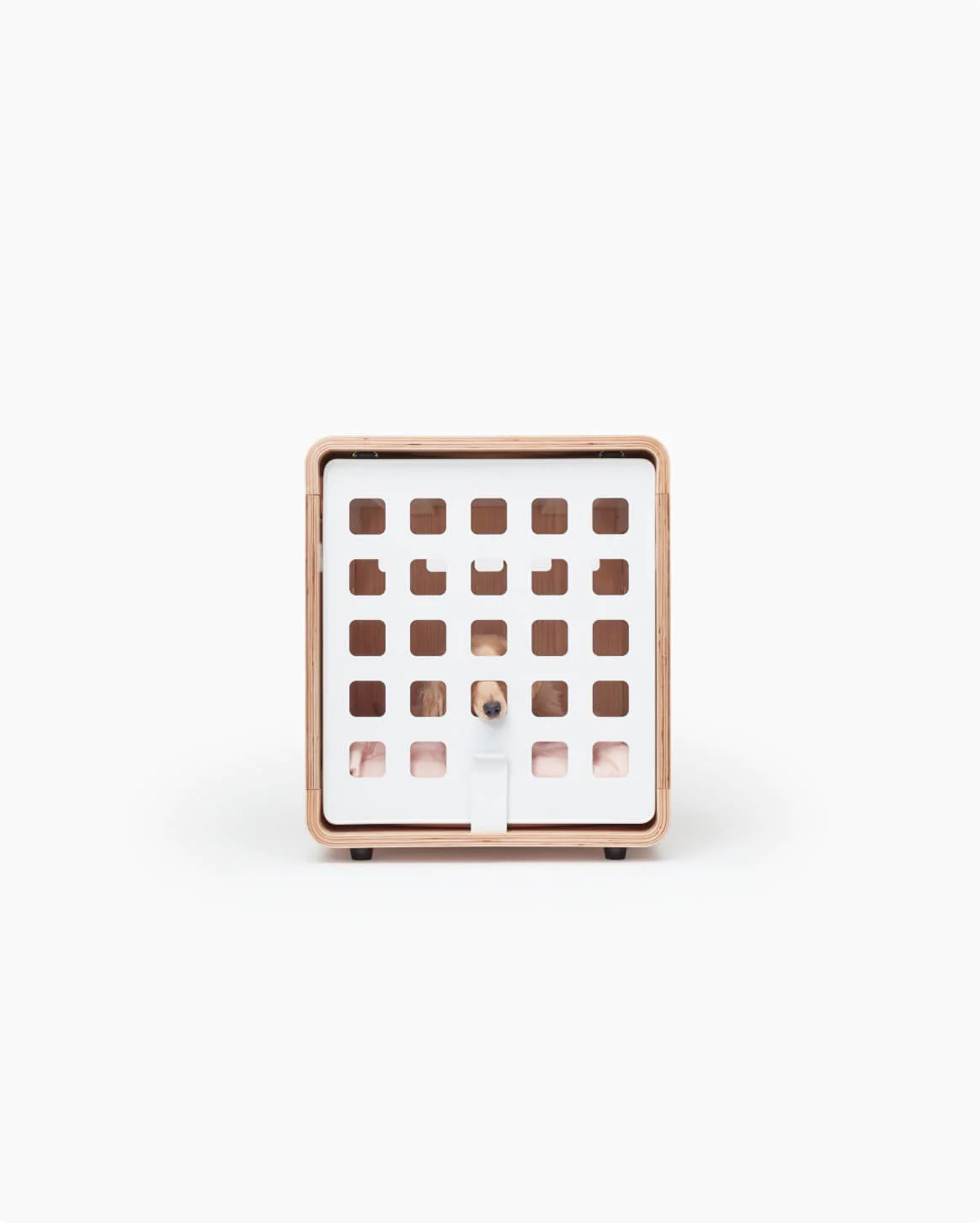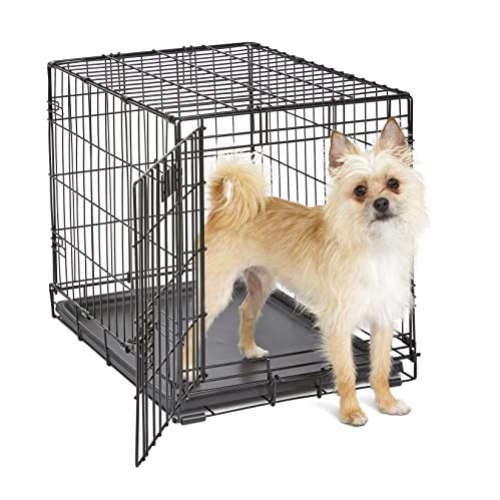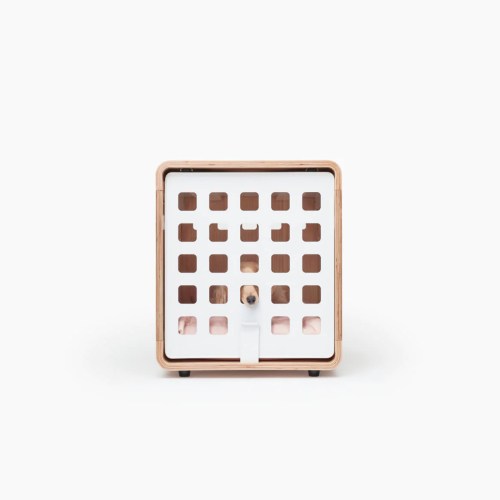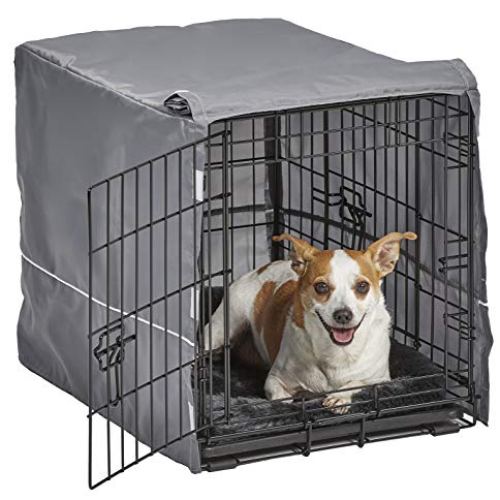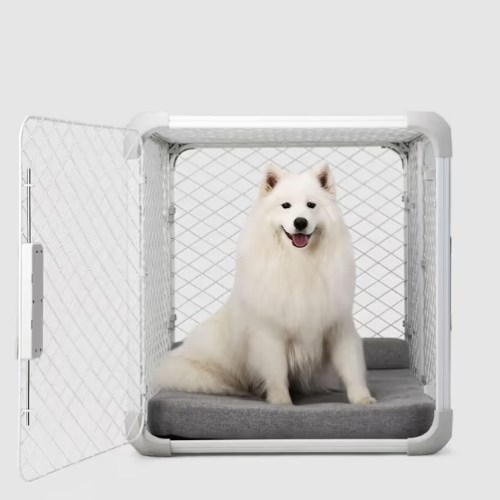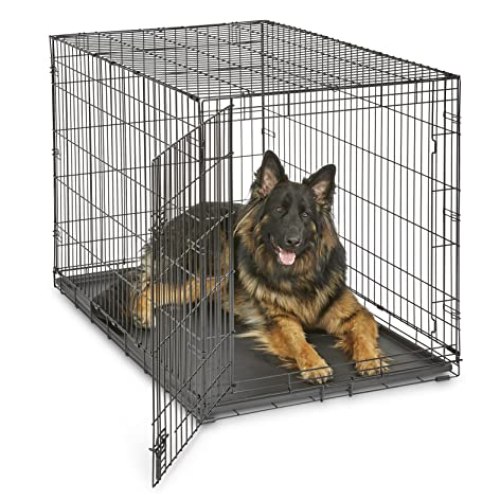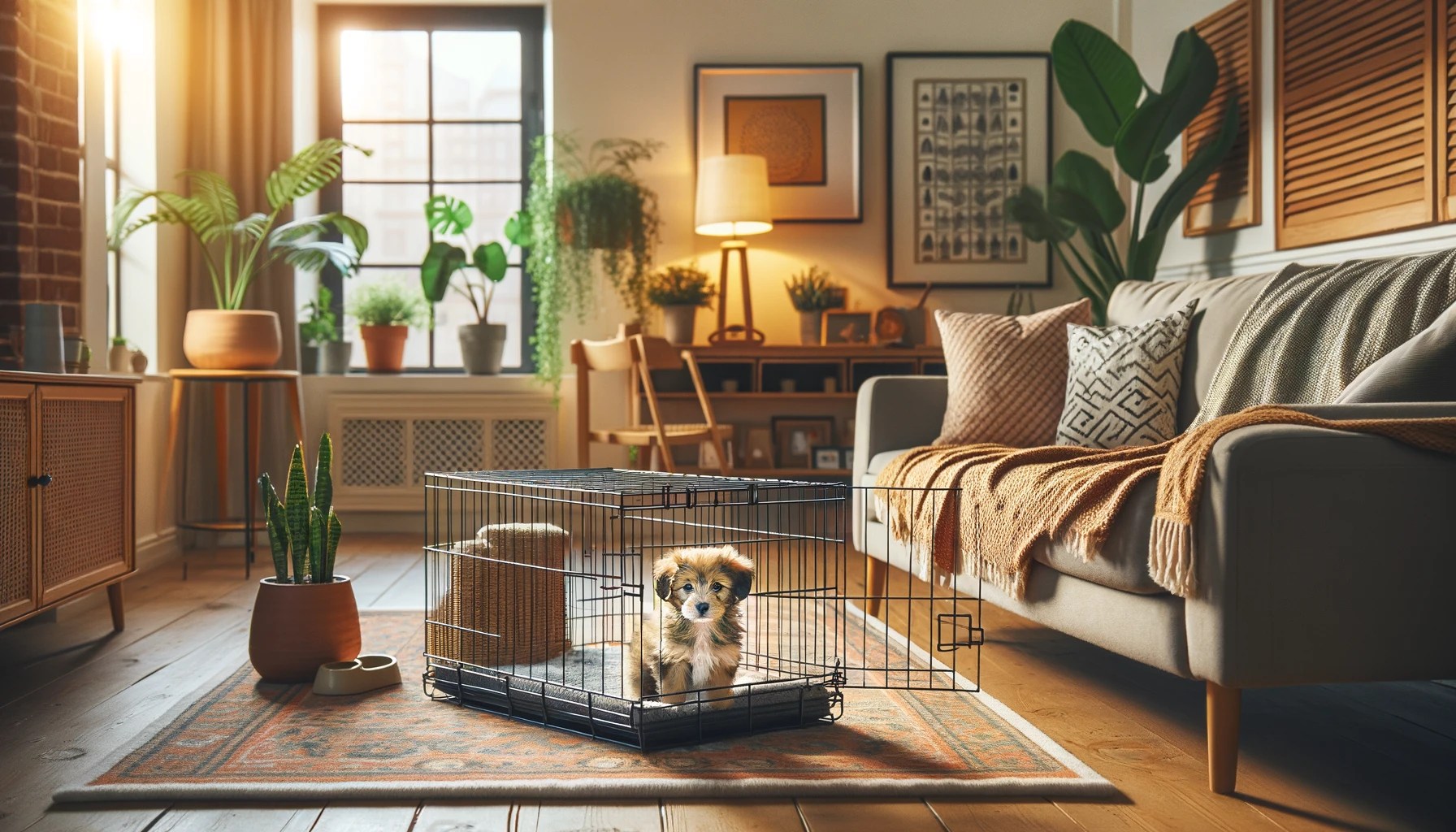
“What size crate is right for my dog?” It’s probably among the most common questions I hear from new puppy owners. That’s why I came up with this comprehensive dog crate sizes guide! Below, I’ll go over everything you need to know, including all the most common sizes, how to measure for a crate, and the other considerations that’ll help you choose the perfect one for your furry friend!
Once you’ve decided on the perfect crate, you’ll need to decide what to put in it to create the ultimate den. So, you may want to check out and bookmark our favorite dog blankets, self-warming dog mats, and the best crate-safe chews. Now, let’s dive into everything you need to know about dog crate sizes, starting with why it’s so important to choose just the right size in the first place.

Importance of Choosing the Perfect Crate Size
Before I dive into the sizes, it’s vital to discuss what makes size an essential consideration. It boils down to a proper-sized crate offers a level of safety and comfort that is needed. The trick is finding a balance between the available space to ensure it’s a perfect size.
A crate shouldn’t offer too much space, or your pup could slip out and cause mayhem. It also can undermine crate training or housetraining if it’s too large. Your dog will simply use the extra space to relieve themselves and halt any sense of progress.
On the other hand, your dog’s crate can’t be too small. Cramped enclosures just don’t offer sufficient comfort/support, and your pup will grow to despise it.
Thankfully, finding a suitable size isn’t too tricky with the right information. It starts with a good handle on the available sizes within this marketplace. So without further ado, let’s discuss all the most common size options.
FYI, this post included affiliate links. If you buy anything through these links, DogVills earns a commission at no extra cost to you.
Common Dog Crate Sizes
Most dog crates often fall into one of six sizes: XS, small, medium, large, XL, and XXL. Let’s look at the standard dimensions for these sizes and some suitable breeds for each. It’ll offer a good reference for when I take you through how to measure a dog.
That said, keep in mind that there aren’t any industry-wide size rules. So, don’t just look at the letters
1. XS Crate (20-23L X 16-18H inches)
As you can imagine, XS (extra small) crates are for the smaller breeds. These crates should be around 20 inches long and at least 16 to 18 inches tall. I’d suggest that anything smaller than these dimensions isn’t worth purchasing (unless for puppy use).
Generally, most smaller toy breeds use an XS crate. Many dogs with the following measurements favor well inside these enclosures:
- under 15 pounds
- less than 16 inches long
- shorter than 12 inches tall.
I had a great one set up when crate training a foster Chihuahua who soon considered it her property; she’d snarl at any dog that attempted to enter even when she wasn’t using it.
Suitable Dog Breeds for XS Crates:
- Chihuahua
- Maltese
- Most puppies
- Pomeranian
- Pug
For those on a tight budget or who just need a basic option, I recommend the Midwest iCrate. It’s a sturdy, affordable option that would work perfectly for travel, potty training, or crate training. It comes in nearly all of the sizes we’re talking about here today, too.
MidWest iCrate Dog Crate
The Midwest iCrate features:
- Two Door Design provides flexibility in placement in the home
- Folding Crate with carry handle makes for easy movement, setup or storage with no tools required
- ABS plastic handles allow for easy carrying
- Divider panel lets you adjust the living area as your pet grows
- Composite pan makes cleaning up accidents easy
- Safe and secure slide bolt latch
Shop on Amazon
Shop on Petco
We earn a commission if you make a purchase, at no additional cost to you.
03/18/2024 02:07 pm GMT
If you want a dog crate that looks like furniture and have a decent-sized budget, I also recommend checking out this one from Fable Pets.
Crate by Fable Pets
The Fable Pets signature Crate features:
- Premium bentwood
- Two finishes—signature and limited-edition walnut
- A sliding gate that can be tucked up and hidden away
- A beautiful designed that mimics a natural dog den.
Shop on Fable Pets
We earn a commission if you make a purchase, at no additional cost to you.
2. Small Crate (24-29L X 19-21H)
The small crates are made especially for dogs between 15 and 25 pounds. In most cases, they will be anywhere from 24 to 29” long while being 19 to 21” tall. These options are ideal for dogs that don’t quite fit into the toy breed group, such as Jack Russell Terriers and Shih Tzus.
For example, nobody would call a Jack Russell Terrier a medium or large-sized breed. But they require more space than a Pug or Maltese as they’re much more active. The additional space of a small-sized crate can help calm them and release some energy. It’s not only Jack Russell Terriers would benefit, either.
Suitable Dog Breeds for Small Crates:
- Bichon Frise
- Boston Terrier
- Havanese
- Jack Russell Terrier
- Shih Tzu
Any dog under 25 pounds and over 16 inches tall would thrive with a small-sized crate. This New World Pet Products crate would be a great option. I’ve had this one recommended to me by several small breed owners.
3. Medium Crate (30-35L X 22-24H)
Medium crates pair well with dogs who are between 25 and 40 pounds. These enclosures measure between 30-35L X 22-24H. In other words, these crates are perfect for breeds like Beagles, Corgis, French Bulldogs, and West Highland Terriers. As a Beagle owner myself, I found them to be more than sturdy and spacious enough.
Suitable Dog Breeds for Medium Crates:
- Beagle
- Corgi
- French Bulldog
- King Charles Spaniel
- West Highland Terrier
I’ve had several crates like this one at around 32L X 23H that offered everything I wanted. It’s a perfect size for his particular measurements and ensures he can’t escape when I put him in it.
I don’t think my Beagle could be any happier with this crate. He spends about half the day inside, snoring up a storm.
4. Large Crate (36-41L X 25-27H)
Large crates range from 36-41” long and 25-27” tall. Therefore, owners will need to set aside some space inside their households. Otherwise, finding a place for it will bring strain and stress into your life.
In most cases, these crates will be acceptable for any breed between 40 and 70 pounds. Some favorites fall into this range, like Bull Terriers and Bulldogs. In particular, I’ve found Bull Terriers to love having a crate and adapt well to training methods using them.
Suitable Dog Breeds for Large Crates:
- Bulldog
- Bull Terrier
- Pit Bull Terrier
- Standard Poodles
- Welsh Corgi
You can expect large crates to be where these enclosures start getting costly. Spending over $60 on crates this size is considered the standard. If you have a bit more room in your budget, though, and you need something super sturdy (say for a pit bull) check out this one from Diggs. It’s pricey, yes, but it’s built to last from puppyhood through adulthood.
Evolv Dog Crate by Diggs
Evolv is Diggs’ slimmest dog crate with novel “playpen mode” and modular design.
- Removable ceiling converts crate into playpen with ceiling frame add-on
- 2 doors included.
- Add additional doors up for up to to 4 configurable doors
- High-strength durable steel frame and wire mesh
- Available in 4 sizes
- No tools needed for assembly
Shop Now
We earn a commission if you make a purchase, at no additional cost to you.
5. XL Crate (42-47L X 28-30H)
XL crates are the perfect options for two of our most popular breeds, Golden Retrievers and Labrador Retrievers. Both breeds range between 70 and 90 pounds while rarely standing taller than 24 inches. So they’d have no issues fitting inside an XL crate (42-47L X 28-30H) comfortably.
You’d even have enough room for a comfortable bed and toys. As a result, it’ll be a cozy place for them to wind down when you’re working or hanging around the house. You also won’t feel bad about locking them inside the crate if they’re home alone.
But ensure the locking mechanisms are top-tier. These breeds are smart enough to escape a subpar crate.
Suitable Dog Breeds for XL Crates:
- Airedale Terrier
- Boxer
- Giant Schnauzer
- Golden Retriever
- Labrador Retriever
6. XXL Crate (48+L X 31+H)
Dog owners with massive pups over 110 pounds can have issues finding a solid crate. Most crate companies stop producing options past the XXL size (48L X 31H). These choices are often perfect for any pup who weighs between 90 and 110 pounds: German Shepherds, Bloodhounds, Cane Corso, and similar-sized breeds.
But someone with a Great Dane or St. Bernard will need a customized crate. These breeds are too large for most standard crates on Amazon or other sites. In these situations, it’s necessary to know your dog’s measurements.
You can then readily provide them to whoever is customizing the crate. It’s where knowing how to measure your dog is essential. It’ll ensure a large breed owner can purchase a crate that meets their dog’s needs and comfort.
Suitable Dog Breeds for XXL Crates:
- Bloodhounds
- Bernese Mountain Dog
- Cane Corso
- German Shepherds (most are under 90, but they need more sturdiness in a crate)
- Rottweiler
New World Newly Enhanced Single Door New World Dog Crate
New World single door dog crate measures 48Lx30Wx33H inches and is suitable for extra-large dog breeds with an adult weight of 90-110 pounds. If your dog’s weight or measurements are on the higher side for this crate, we recommend the next crate size up
Shop Now
We earn a commission if you make a purchase, at no additional cost to you.
03/20/2024 02:19 pm GMT
How to Measure Your Dog for a Crate
Some people will want to skip the measuring step and use the breed standard measurements. But it’s better to get an accurate measurement and use it to find the perfect crate. Plus, the process couldn’t be less time-consuming and easy:
Step 1: Collect the Necessary Supplies
All a person needs to begin is a soft tape measure and treats. But it’s crucial to ensure your choice of treats is something your dog enjoys. Stay with the favorites rather than using a new, untested product.
Once you have these two items, the only thing left to collect is your dog. I’d let them sniff the measuring tape before moving to step 2. It’ll provide them with some comfort to ensure they don’t react weirdly.
Step 2: Measure Your Dog’s Height
Your starting point should be getting them in a sitting position. Once they’re sitting, use your measuring tape the distance from their front paw’s base to the top of their head. Anyone having problems with them sitting still can use treats as a reward.
Step 3: Measure Your Dog’s Length
After writing down the height measurements, determine your dog’s length. This process requires measuring the tail’s base to the nose’s top in a straight line. Record the measurement somewhere you won’t forget it.
Some dogs become uncomfortable with the tape measure during this process. So again, use the treats to your advantage and calm them.
Step 4: Provide Some Wiggle Room
The last step is adding some wiggle room to your dog’s measurements. Most experts recommend adding four inches to your dog’s length and height. From there, a crate matching those specific numbers should be a perfect size.
For those who need a visual guide, check out this video below:
Other Factors to Consider When Selecting a Dog Crate
A crate’s size is only one part of selecting the perfect option. I thought it’d be wise to discuss several other factors that need consideration. Hopefully, these discussions will help you further lock into a specific option for your pup.
1. Construction Material Type
Dog crates are a more varied product than most people assume. The one area where these enclosures can differ in a significant way is their primary construction material. You’ll find options made from plastic, wood, fabric, and metal. Each type has benefits and downsides that need consideration from buyers:
- Plastic Crates: These options are great for use inside the house and travel. Their versatility comes from being easy to clean and more portable than other crates. But these products aren’t the sturdiest options, which makes them a lousy choice for anyone with a chewer.
- Wood Crates: No other type can match a wood crate’s style or durability. In other words, these crates are stable constructions that mesh perfectly with a home’s decor. But they’re expensive, hard to clean, weigh a ton, and require assembly.
- Fabric Crates: Owners looking for a quick, affordable, and lightweight option will want to choose a fabric crate. Small-breed dogs without chewing issues are the best choice to work with these options. Some people also use them as a secondary option for travel if they have a more sturdy crate at home.
- Metal Crates: Dogs with chewing issues hate this type. Metal crates will stand up against even the worst chewers while offering ventilation and visibility. But they’re incapable of meshing into home decor. Even still, I’d be lying if I didn’t consider them my favorite among these options.
2. Sturdiness
Construction material will only tell part of the story concerning a crate’s sturdiness. For instance, I’ve seen various wood crates that fail against a determined pup. That’s why looking into all the features is essential when selecting these products.
If I’m being honest, no other resource will help a person evaluate this aspect more than customer reviews. Our fellow dog owners have no problem ripping apart a product that doesn’t meet expectations. Use their experiences to your advantage, especially when researching a crate’s sturdiness.
3. Comfort
Dog crates should be a comfortable place for your pup to rest. I suggest cultivating a relaxing environment by placing a bed and toys inside them. It’ll help your dog feel cozy and secure when lying in the crate.
Meanwhile, the crate itself should provide excellent ventilation. It could be through holes, wire mesh, or anything that allows them to breathe easily. It may seem like common sense, but I’ve found some crates don’t do a good enough job in this area.
4. Locking Mechanism
Locking mechanisms are a pivotal component of dog crates. They’re responsible for keeping a dog secure when locked inside the enclosure. But the quality isn’t always up to par with every crate.
So research each crate’s locking mechanism to ensure it’s effective. Otherwise, you’ll come home from grocery shopping and find your furniture ripped apart. Trust me; it’s happened to me on more than one occasion when trusting faulty crates.
5. Your Dog’s Growth
After buying a crate, your dog’s growth doesn’t stop. It’d be wise to plan for it by accounting for expected growth when purchasing one. I recommend using breed standards if your dog hasn’t reached adult age.
One way to plan for this growth is by buying wire dog crates with divider panels. This feature allows you to adjust the space inside and provide more as your pup grows. It’s a simple way to avoid buying multiple enclosures throughout their life.
Sadly, I didn’t even think about it with my Beagle or Pitbull and bought several crates throughout their lives. It wasn’t a wise move as I could’ve saved so much money.
Conclusion
After learning all about crate sizes, selecting a perfect crate will be much easier. It’s a simple process of measuring your dog’s height/length, adding 4 inches to the measurements, and proceeding to find options with those dimensions. You’ll then use other considerations like its sturdiness and material type to hone onto a single crate.
But anyone who still has concerns can let me know in the comment section. I’d be happy to answer any questions and do whatever possible to help you find the perfect crate for your dog. Thanks for reading!

